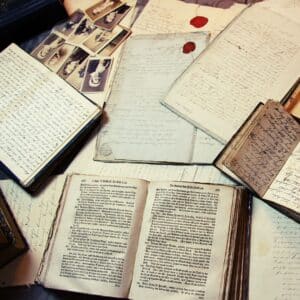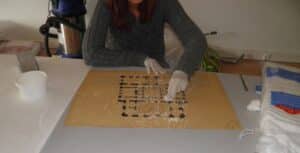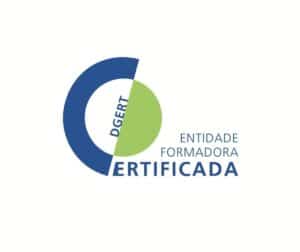How to clean antique books – In this article we will adress the best way to do this and reflect on the practical and ethical issues involved in the process of cleaning antique books .
Cleaning is a very important interventional conservation procedure that is often overlooked and for which the necessary rules of procedure are not established.
You can deepen the methodologies described in this article on how to clean antique books in the online course Conservation of Documents and Books
Antique books | why clean?
Often the hygiene of antique books is devalued because it is a type of treatment whose results are not easily visible.
However, dust and “dirt” are important degradation agents. Conjugated with favorable environmental conditions, they can cause destruction in all type of supports and are food for diverse organisms.

For this reason, their removal is critical to the preservation of any book or document.
It is recommended that, as regularly as possible, a job of cleaning all the volumes to be preserved should be carried out.
This type of intervention helps to remove harmful particles from the surface, such as dust, fungi, and insect debris, which may otherwise get entangled in the materials.
How to clean antique books – previous aspects
The following recommendations and aspects should therefore be taken into account
1 – This is an essential procedure because dust and ‘dirt’ are important agents of degradation: combined with favourable environmental conditions, they can cause destructive reactions in all kinds of supports and serve as a culture medium and food source for various organisms.
2 – This is the first intervention before any other conservation action. This type of intervention helps to remove harmful particles from the surface, such as dust, fungi and insect droppings, which could otherwise become entrenched in the materials.
3 – The cleaning methods used should be chosen according to the state of conservation of the book or document. It is recommended that, whenever possible and always beforehand, cleaning should be carried out using dry methods, as this is safer for the material to be treated.
4 – It’s irreversible. Anything removed by cleaning cannot be replaced, so the level of cleaning to be carried out must be carefully assessed, not only to prevent possible damage to the documents and books, but also so as not to remove ‘additions’ that could be considered part of their own history.
Methods of hygiene for antique books
The methods of hygiene used should be chosen according to the state of conservation of the book or document.
It is recommended that dry cleaning should be done whenever possible, as it is safer for the material to be treated.
Wet cleaning should only be carried out by specialized technicians and only in cases where dry cleaning is not successful, because the paper is more susceptible to damage.
There is a great variety of materials and equipment to carry out the hygiene of books and documents available in the market.
Caution: proper equipment must be selected. Take into account the integrity of the surface to be cleaned and the inks, without risk of damage.
Let’s look at a simple method that may contribute to the longevity of your antique books
Cleaning with grated white rubber
White rubber can be grated (e.g. with a kitchen grater) and passed over the surface to be cleaned with the help of a cotton dummy or cloth, which will gently remove dirt; the remains of the rubber should be removed with a soft brush or paintbrush.

In the examples, Staedler rubbers have been used, and they have given the best results. However, they should always be tested in an inconspicuous area before use, even if they are of the recommended type and brand, to make sure there are no problems.
Cleaning with a soft rubber or smoke sponge
For surface dirt, these two types of materials may be suitable as they remove dirt films without damaging the substrate, provided they are used with care and attention.
Here’s an example
Conservation of Documents and Books
In the certified online course Conservation of Documents and Books, learn how to identify the main factors in the deterioration of documents and books, how to prevent their degradation and how to minimise its effects.
With clear instructions and analyses of practical cases.


